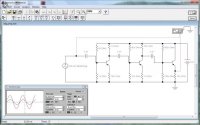Hey, hey, well done Daniel.
You found a simulator, and got a running circuit!
And, you've acquired the grasp of how this thing works.
This circuit is a bit tricky. It has to use reverse logic, a low input turns it on, a high input turns it off. This normally requires at least 2 NPN transistors, more abundant than PNP. But can be done with a single PNP, if you understand the upside-down realm it's in. Its on/off characteristics depend on the voltage/current states between the base and emitter, same as with NPN, but occurring at the top of the transistor symbol, instead of at the bottom, where there's a reliable ground. In this circuit, the voltage/current at the emitter wanders, depending on what's going thru the relay coil. The key is to get the right values of R1 and R2 to get the base to flow, or shutoff. If the value of R2 is too high, it may not pass enuff current from Q1's base to keep the relay turned on. If the value is too low, it'll pull the divided voltage (R1/R2) too low and turn the relay on.
On my tablet, I'm using an Android app, EveryCircuit.
http://everycircuit.com
In this app, I can define various parameter values for components.
For the relay (using nominal values from your supplied spec sheet):
Coil resistance = 100 ohms
Pull-in voltage = 6v
Release voltage = 3v
For the PNP transistor (typical 2N3906):
HFE (gain) = 100 (also known as beta)
I'm using 12v for the battery voltage. Maybe could try variations from 9v to 14.5v see if the circuit works for most expected conditions.
I couldn't see any pull-in/release values for the relay in your circuit, and saw that Beta is set to 50 on your transistor. Could see if you can change those. Might then get it to work with a different R2 value.
Here, I'm demonstrating the Kettering (points) ignition on EveryCircuit.
Long ago, I bought a PC/DOS based simulator, Electronics Workbench (aka EWB). It was acquired by National Instruments, updated to run on Windows, and the last version v5.12 is available as a free download. If interested, Google "electronics workbench ewb".

What's nice about these simulators is that sometimes you don't need to be perfect, just get a theoretical version working, then do the fine tuning while breadboarding...


